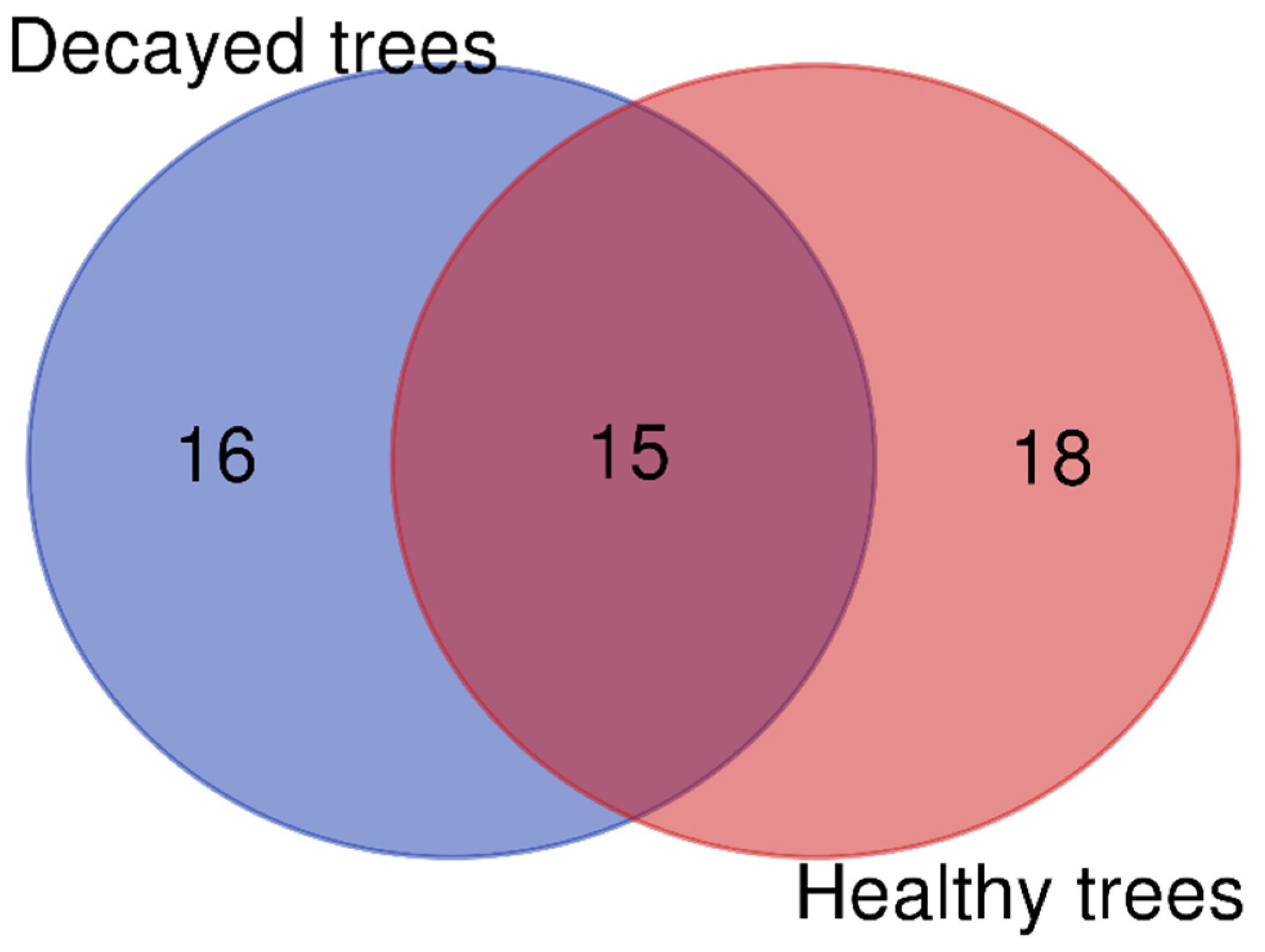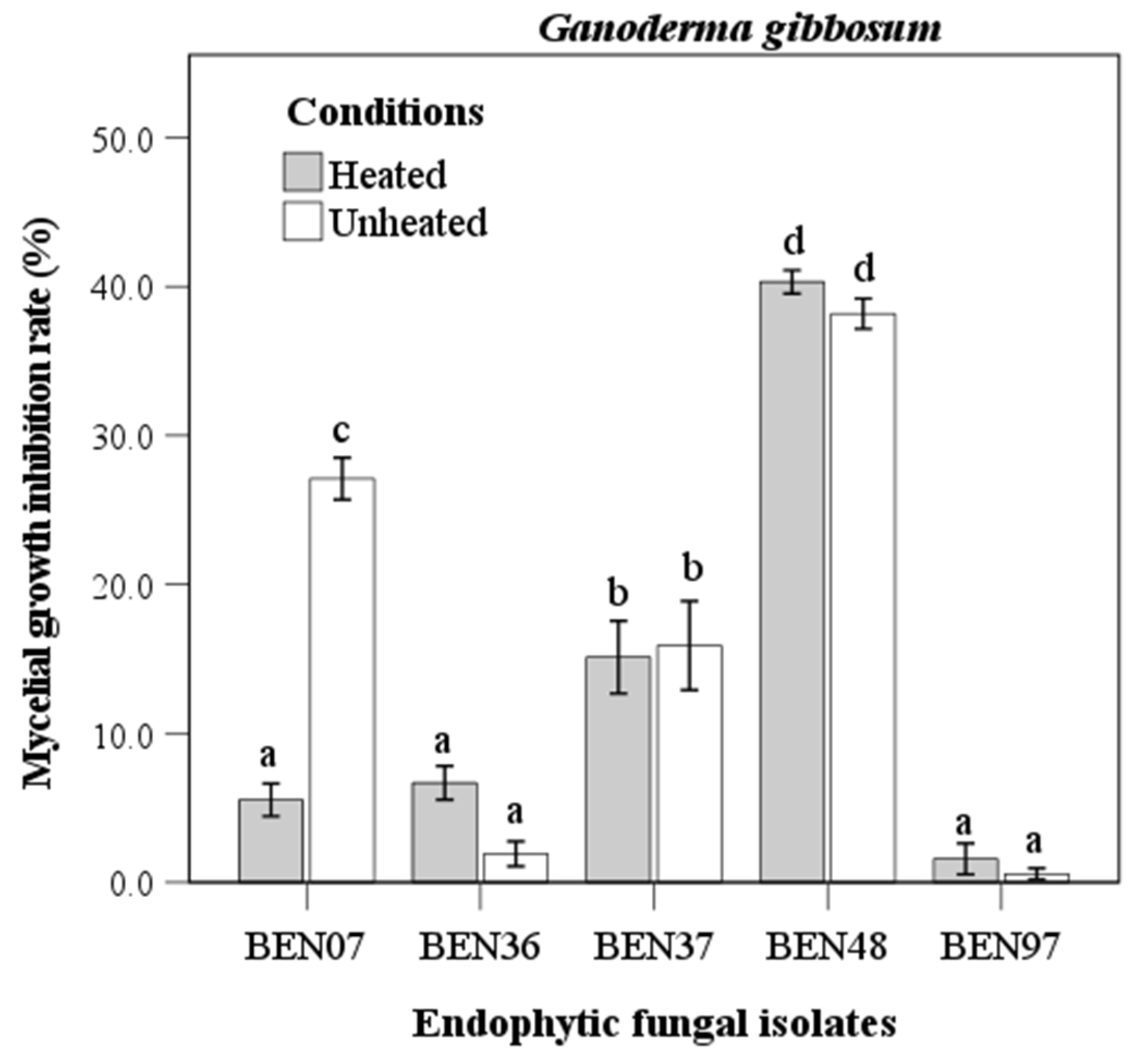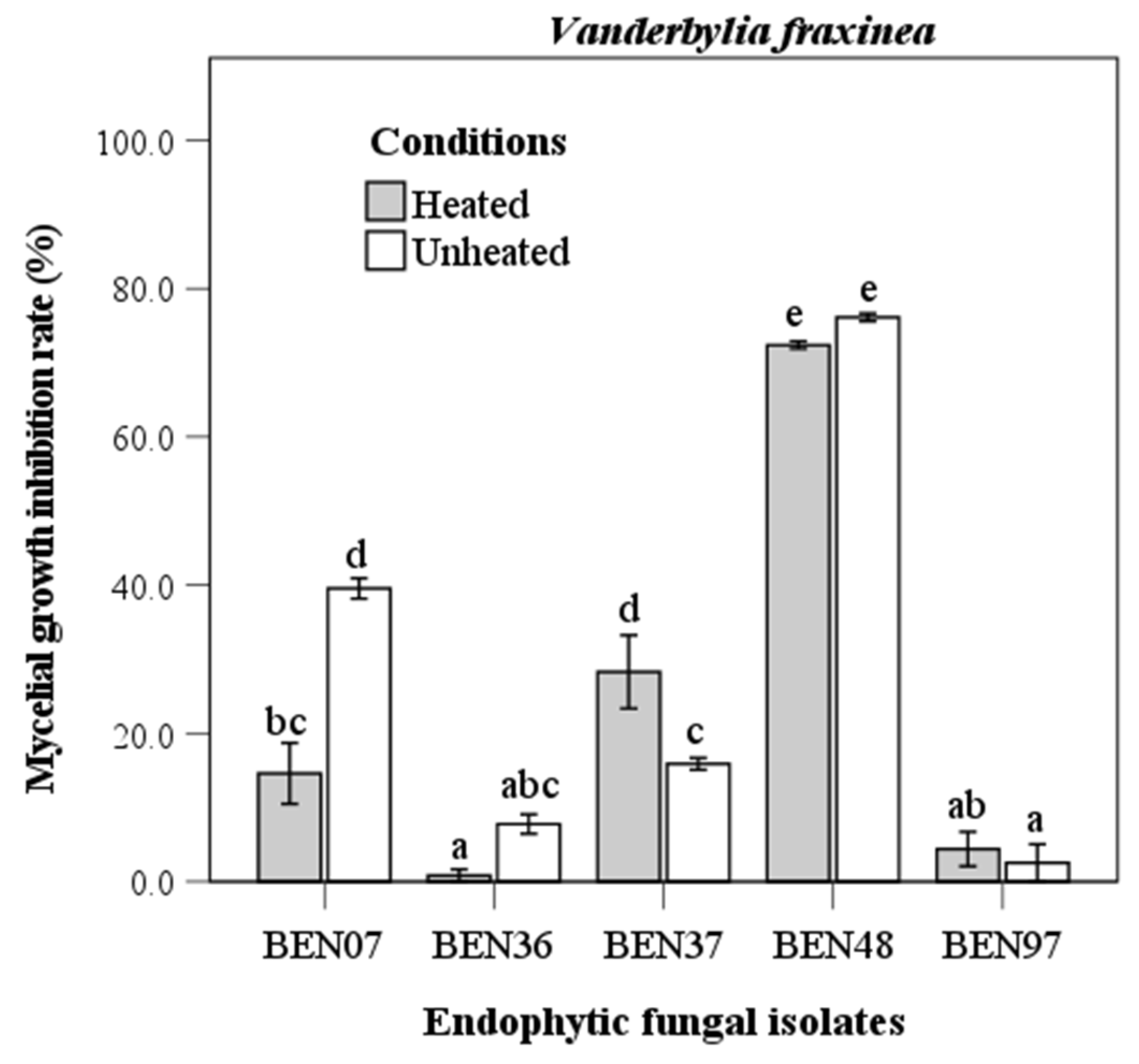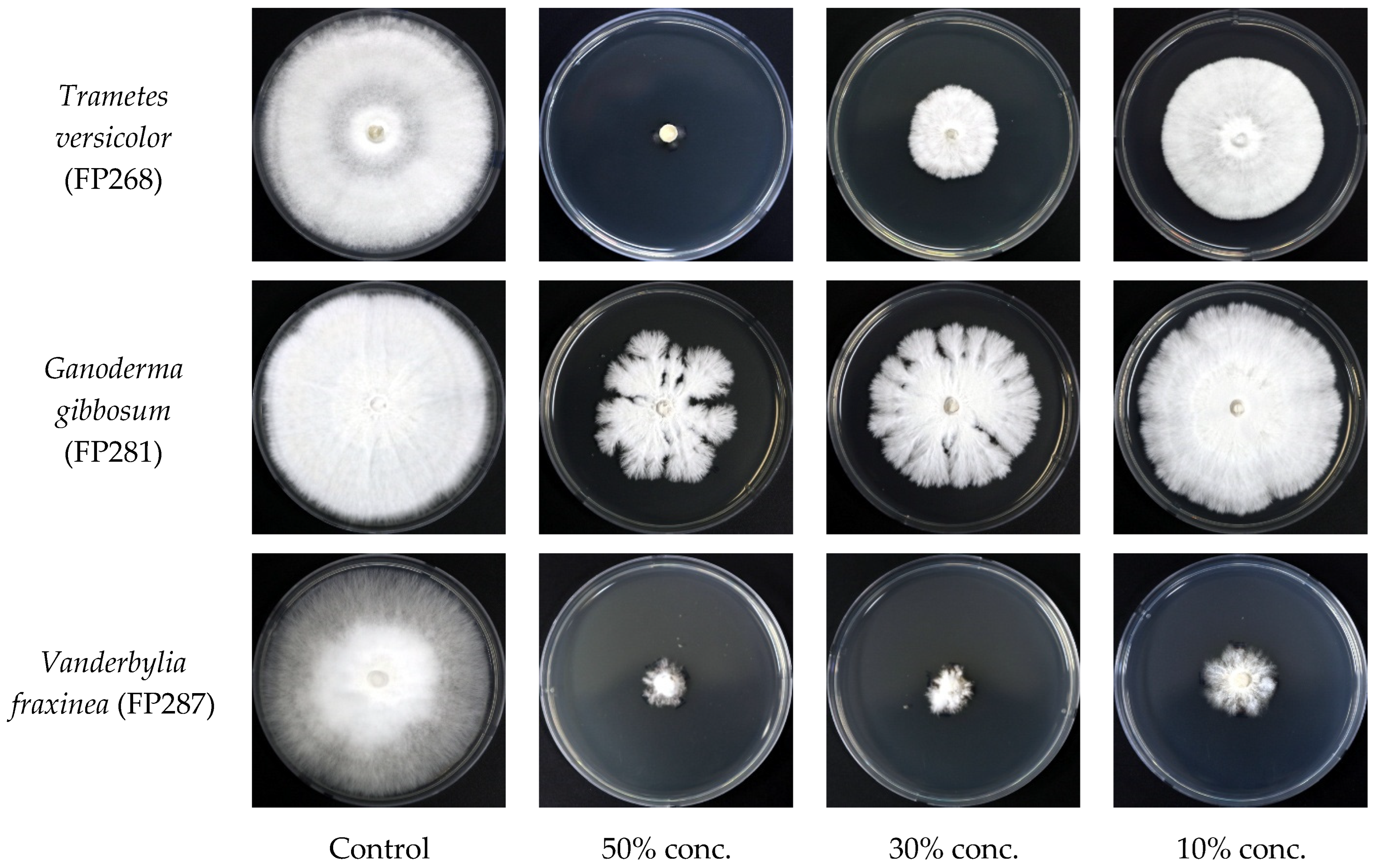Diversity of Endophytic Fungi Isolated from Prunus yedoensis and Their Antifungal Activity Against Wood Decay Fungi
Abstract
1. Introduction
2. Materials and Methods
2.1. Isolation of Endophytic Fungi
2.2. Identification of Endophytic Fungi
2.3. Testing for Antifungal Activities of Isolated Endophytic Fungi
2.4. Antifungal Activities of Culture Filtrates from Selected Endophytic Fungi
2.5. Statistical Analysis
3. Results
3.1. Diversity of Endophytic Fungi Isolated from P. yedoensis
3.2. Screening of Endophytic Fungi Against Wood Decay Fungi in Dual Culture Test
3.3. Inhibitory Activity of Culture Filtrate Against Wood Decay Fungi
3.4. Effects of Culture Filtrate Concentration of Endophytic Fungi on Antifungal Activity
4. Discussion
5. Conclusions
Author Contributions
Funding
Institutional Review Board Statement
Informed Consent Statement
Data Availability Statement
Conflicts of Interest
References
- Pirttilä, A.M.; Frank, A.C. Endophytes of Forest Trees: Biology and Applications, 2nd ed.; Forestry Sciences; Springer International Publishing AG: Cham, Switzerland, 2018; ISBN 978-3-319-89832-2. [Google Scholar]
- Sun, X.; Guo, L.-D. Endophytic Fungal Diversity: Review of Traditional and Molecular Techniques. Mycology 2012, 3, 65–76. [Google Scholar] [CrossRef]
- Rashmi, M.; Kushveer, J.S.; Sarma, V.V. A Worldwide List of Endophytic Fungi with Notes on Ecology and Diversity. Mycosphere 2019, 10, 798–1079. [Google Scholar] [CrossRef]
- Aly, A.H.; Debbab, A.; Proksch, P. Fungal Endophytes: Unique Plant Inhabitants with Great Promises. Appl. Microbiol. Biotechnol. 2011, 90, 1829–1845. [Google Scholar] [CrossRef] [PubMed]
- Pirttilä, A.M.; Frank, A.C. (Eds.) Endophytes of Forest Trees: Biology and Applications; Forestry Sciences; Springer: Dordrecht, The Netherlands; New York, NY, USA, 2011; ISBN 978-94-007-1598-1. [Google Scholar]
- Jia, Q.; Qu, J.; Mu, H.; Sun, H.; Wu, C. Foliar Endophytic Fungi: Diversity in Species and Functions in Forest Ecosystems. Symbiosis 2020, 80, 103–132. [Google Scholar] [CrossRef]
- Arnold, A.E. Understanding the Diversity of Foliar Endophytic Fungi: Progress, Challenges, and Frontiers. Fungal Biol. Rev. 2007, 21, 51–66. [Google Scholar] [CrossRef]
- Gamboa, M.A.; Laureano, S.; Bayman, P. Measuring Diversity of Endophytic Fungi in Leaf Fragments: Does Size Matter? Mycopathologia 2003, 156, 41–45. [Google Scholar] [CrossRef]
- Stone, J.K.; Polishook, J.D.; White, J.F. Endophytic Fungi. In Biodiversity of Fungi; Elsevier: Amsterdam, The Netherlands, 2004; pp. 241–270. ISBN 978-0-12-509551-8. [Google Scholar]
- Posada, F.; Vega, F.E. Inoculation and Colonization of Coffee Seedlings (Coffea arabica L.) with the Fungal Entomopathogen Beauveria bassiana (Ascomycota: Hypocreales). Mycoscience 2006, 47, 284–289. [Google Scholar] [CrossRef]
- Nair, D.N.; Padmavathy, S. Impact of Endophytic Microorganisms on Plants, Environment and Humans. Sci. World J. 2014, 2014, 250693. [Google Scholar] [CrossRef]
- Nguyen, M.H.; Yong, J.H.; Sung, H.J.; Lee, J.K. Screening of Endophytic Fungal Isolates Against Raffaelea quercus-mongolicae Causing Oak Wilt Disease in Korea. Mycobiology 2020, 48, 484–494. [Google Scholar] [CrossRef]
- Nguyen, M.H.; Park, I.-K.; Lee, J.K.; Lee, D.-H.; Shin, K. Antifungal Activity of Culture Filtrate from Endophytic Fungus Nectria balsamea E282 and Its Fractions against Dryadomyces quercus-mongolicae. Forests 2024, 15, 332. [Google Scholar] [CrossRef]
- Masi, M.; Maddau, L.; Linaldeddu, B.T.; Scanu, B.; Evidente, A.; Cimmino, A. Bioactive Metabolites from Pathogenic and Endophytic Fungi of Forest Trees. Curr. Med. Chem. 2018, 25, 208–252. [Google Scholar] [CrossRef] [PubMed]
- Puri, S.K.; Habbu, P.V.; Kulkarni, P.V.; Kulkarni, V.H. Nitrogen Containing Secondary Metabolites from Endophytes of Medicinal Plants and Their Biological/Pharmacological Activities—A Review. Syst. Rev. Pharm. 2018, 9, 22–30. [Google Scholar] [CrossRef]
- Qin, J.-C.; Zhang, Y.-M.; Gao, J.-M.; Bai, M.-S.; Yang, S.-X.; Laatsch, H.; Zhang, A.-L. Bioactive Metabolites Produced by Chaetomium globosum, an Endophytic Fungus Isolated from Ginkgo Biloba. Bioorg. Med. Chem. Lett. 2009, 19, 1572–1574. [Google Scholar] [CrossRef] [PubMed]
- Omoto, Y.; Aono, Y. Effect of Urban Warming on Blooming of Prunus yedoensis. Energy Build. 1991, 15–16, 205–212. [Google Scholar] [CrossRef]
- Zhang, Y.Q.; Guan, L.; Zhong, Z.Y.; Chang, M.; Zhang, D.K.; Li, H.; Lai, W. The Anti-inflammatory Effect of Cherry Blossom Extract (Prunus Yedoensis) Used in Soothing Skincare Product. Int. J. Cosmet. Sci. 2014, 36, 527–530. [Google Scholar] [CrossRef]
- Kim, D.H. Practical Methods for Rapid Seed Germination from Seed Coat-Imposed Dormancy of Prunus yedoensis. Sci. Hortic. 2019, 243, 451–456. [Google Scholar] [CrossRef]
- Hwang, Y.; Kim, J.; Ryu, Y. Canopy Structural Changes Explain Reductions in Canopy-Level Solar Induced Chlorophyll Fluorescence in Prunus yedoensis Seedlings under a Drought Stress Condition. Remote Sens. Environ. 2023, 296, 113733. [Google Scholar] [CrossRef]
- Kim, C.; Kim, C.-S.; Mun, J.-H.; Kim, J.-H. Epitypification of Prunus × nudiflora (Rosaceae), a Natural Hybrid Species in Jeju Island, Korea. J. Asia-Pac. Biodivers. 2019, 12, 718–720. [Google Scholar] [CrossRef]
- Kim, C.-S.; Kim, Z.-S. Effects of Cutting Time, Auxin Treatment, and Cutting Position on Rooting of the Green-Wood Cuttings and Growth Characteristics of Transplanted Cuttings in the Adult Prunus yedoensis. Korean J. Hortic. Sci. Technol. 2012, 30, 129–136. [Google Scholar] [CrossRef]
- Cheong, E.J.; Na, M.; Jeong, U. The Effect of Endophytic Bacteria on in Vitro Shoot Growth of Prunus yedoensis and Its Identification and Elimination. In Vitro Cell. Dev. Biol.-Plant 2020, 56, 200–206. [Google Scholar] [CrossRef]
- Cheong, E.J.; Kim, C.S. Differentiation of Winter Buds of Prunus yedoensis Matsumura from Jeju Island Depending on the Collection Time and Media Conditions. J. Korean Soc. For. Sci. 2000, 89, 522–526. [Google Scholar]
- Velmurugan, P.; Cho, M.; Lim, S.-S.; Seo, S.-K.; Myung, H.; Bang, K.-S.; Sivakumar, S.; Cho, K.-M.; Oh, B.-T. Phytosynthesis of Silver Nanoparticles by Prunus yedoensis Leaf Extract and Their Antimicrobial Activity. Mater. Lett. 2015, 138, 272–275. [Google Scholar] [CrossRef]
- Velmurugan, P.; Sivakumar, S.; Song, Y.C.; Jang, S.H. Crystallization of Silver Metal by Extract of Prunus × yedoensis Matsumura Blossoms and Its Potential Characterization. J. Ind. Eng. Chem. 2015, 31, 39–42. [Google Scholar] [CrossRef]
- Manikandan, V.; Velmurugan, P.; Park, J.-H.; Lovanh, N.; Seo, S.-K.; Jayanthi, P.; Park, Y.-J.; Cho, M.; Oh, B.-T. Synthesis and Antimicrobial Activity of Palladium Nanoparticles from Prunus × yedoensis Leaf Extract. Mater. Lett. 2016, 185, 335–338. [Google Scholar] [CrossRef]
- Manikandan, V.; Velmurugan, P.; Hong, S.-C.; Yi, P.-I.; Jang, S.-H.; Suh, J.-M.; Jung, E.-S.; Russel, M.; Sivakumar, S. Novel Green Synthesis of a Reduced Graphene Oxide/Zinc Oxide Hybrid Nanocomposite Adsorbent of Prunus × yedoensis Leaf Extract: Its Catalytic Potential to Remove Phosphate. Desalination Water Treat. 2018, 130, 124–131. [Google Scholar] [CrossRef]
- Cho, S.-E.; Kang, H.; Lee, D.-H.; Seo, S.-T.; Kim, N.; Lee, S.; Kim, M.; Shin, K. The Complete Mitochondrial Genome of a Wood-Decaying Fungus Vanderbylia Fraxinea (Polyporaceae, Polyporales). Mitochondrial DNA Part B 2023, 8, 1187–1191. [Google Scholar] [CrossRef]
- Cho, S.-E.; Lee, S.-G.; Kim, M.-S.; Park, S.-H.; Park, J.-B.; Kim, N.-K.; Seo, S.-T.; Lee, D.-H.; Shin, K. First Report of Ganoderma gibbosum (Ganodermataceae, Basidiomycota), a Wood-Rotting Fungus of Urban Trees in Korea. J. Asia-Pac. Biodivers. 2024, 17, 228–231. [Google Scholar] [CrossRef]
- Jung, S.J.; Kim, N.K.; Lee, D.-H.; Hong, S.I.; Lee, J.K. Screening and Evaluation of Streptomyces Species as a Potential Biocontrol Agent against a Wood Decay Fungus, Gloeophyllum trabeum. Mycobiology 2018, 46, 138–146. [Google Scholar] [CrossRef]
- White, T.J.; Bruns, T.; Lee, S.; Taylor, J. Amplification and Direct Sequencing of Fungal Ribosomal RNA Genes for Phylogenetics. In PCR Protocols: A Guide to Methods and Applications; Elsevier: Amsterdam, The Netherlands, 1990; pp. 315–322. ISBN 978-0-12-372180-8. [Google Scholar]
- Nguyen, M.H.; Shin, K.C.; Lee, J.K. Fungal Community Analyses of Endophytic Fungi from Two Oak Species, Quercus mongolica and Quercus serrata, in Korea. Mycobiology 2021, 49, 385–395. [Google Scholar] [CrossRef]
- He, C.; Cui, J.; Chen, X.; Wang, W.; Hou, J. Effects of Enhancement of Liquorice Plants with Dark Septate Endophytes on the Root Growth, Glycyrrhizic Acid and Glycyrrhizin Accumulation Amended with Organic Residues. Curr. Plant Biol. 2020, 23, 100154. [Google Scholar] [CrossRef]
- He, C.; Zeng, Q.; Chen, Y.; Chen, C.; Wang, W.; Hou, J.; Li, X. Colonization by Dark Septate Endophytes Improves the Growth and Rhizosphere Soil Microbiome of Licorice Plants under Different Water Treatments. Appl. Soil. Ecol. 2021, 166, 103993. [Google Scholar] [CrossRef]
- Sathiyaseelan, A.; Saravanakumar, K.; Mariadoss, A.V.A.; Kim, K.M.; Wang, M.-H. Antibacterial Activity of Ethyl Acetate Extract of Endophytic Fungus (Paraconiothyrium Brasiliense) through Targeting Dihydropteroate Synthase (DHPS). Process Biochem. 2021, 111, 27–35. [Google Scholar] [CrossRef]
- Sathiyaseelan, A.; Saravanakumar, K.; Naveen, K.V.; Han, K.-S.; Zhang, X.; Jeong, M.S.; Wang, M.-H. Combination of Paraconiothyrium Brasiliense Fabricated Titanium Dioxide Nanoparticle and Antibiotics Enhanced Antibacterial and Antibiofilm Properties: A Toxicity Evaluation. Environ. Res. 2022, 212, 113237. [Google Scholar] [CrossRef] [PubMed]
- Taguchi, J.; Saito, T.; Yajima, A. Synthesis and Absolute Configuration of Paraconiothin I, a Structurally Unique Sesquiterpene Isolated from the Endophytic Fungus Paraconiothyrium brasiliense ECN258. Tetrahedron Lett. 2023, 131, 154789. [Google Scholar] [CrossRef]
- Hong, A.R.; Yun, J.H.; Yi, S.H.; Lee, J.H.; Seo, S.T.; Lee, J.K. Screening of Antifungal Microorganisms with Strong Biological Activity against Oak Wilt Fungus, Raffaelea quercus-mongolicae. J. For. Environ. Sci. 2018, 34, 395–404. [Google Scholar] [CrossRef]
- Jiang, Y.; Zhang, L.; Wang, S.; Li, Y.; Bai, Y.; Cao, L. Evaluation and Control of Fusarium acuminatum Causing Leaf Spot in Saposhnikovia Divaricata in Northeast China. Plant Dis. 2024, 108, 1139–1145. [Google Scholar] [CrossRef]
- Osawa, H.; Sakamoto, Y.; Akino, S.; Kondo, N. Autumn Potato Seedling Failure Due to Potato Dry Rot in Nagasaki Prefecture, Japan, Caused by Fusarium acuminatum and Fusarium commune. J. Gen. Plant Pathol. 2021, 87, 46–50. [Google Scholar] [CrossRef]
- Karlsson, I.; Persson, P.; Friberg, H. Fusarium Head Blight From a Microbiome Perspective. Front. Microbiol. 2021, 12, 628373. [Google Scholar] [CrossRef]
- Beccari, G.; Prodi, A.; Tini, F.; Bonciarelli, U.; Onofri, A.; Oueslati, S.; Limayma, M.; Covarelli, L. Changes in the Fusarium Head Blight Complex of Malting Barley in a Three-Year Field Experiment in Italy. Toxins 2017, 9, 120. [Google Scholar] [CrossRef]
- Becher, R.; Miedaner, T.; Wirsel, S.G.R. Biology, Diversity, and Management of FHB-Causing Fusarium Species in Small-Grain Cereals. In Agricultural Applications; Kempken, F., Ed.; Springer: Berlin/Heidelberg, Germany, 2013; pp. 199–241. ISBN 978-3-642-36820-2. [Google Scholar]
- Wang, C.W.; Ai, J.; Fan, S.T.; Lv, H.Y.; Qin, H.Y.; Yang, Y.M.; Liu, Y.X. Fusarium acuminatum: A New Pathogen Causing Postharvest Rot on Stored Kiwifruit in China. Plant Dis. 2015, 99, 1644. [Google Scholar] [CrossRef]
- Tang, T.; Wang, F.; Guo, J.; Guo, X.; Duan, Y.; You, J. Fusarium acuminatum Associated with Root Rot of Maidong (Ophiopogon japonicus) in China. Plant Dis. 2021, 105, 1860. [Google Scholar] [CrossRef] [PubMed]
- Wang, Y.; Wang, C.; Ma, Y.; Zhang, X.; Yang, H.; Li, G.; Li, X.; Wang, M.; Zhao, X.; Wang, J.; et al. Rapid and Specific Detection of Fusarium acuminatum and Fusarium solani Associated with Root Rot on Astragalus membranaceus Using Loop-Mediated Isothermal Amplification (LAMP). Eur. J. Plant Pathol. 2022, 163, 305–320. [Google Scholar] [CrossRef]
- Grove, J.F.; Hitchcock, P.B. Metabolic Products of Fusarium acuminatum: Acuminatopyrone and Chlamydosporol. J. Chem. Soc. Perkin Trans. 1 1991, 5, 997–999. [Google Scholar] [CrossRef]
- Kayali, H.A.; Tarhan, L. Variations in Metal Uptake, Antioxidant Enzyme Response and Membrane Lipid Peroxidation Level in Fusarium equiseti and F. acuminatum. Process Biochem. 2005, 40, 1783–1790. [Google Scholar] [CrossRef]







| Isolate No. | Most Closely Related Strain | GenBank Acc. No. | Maximum Identity (%) | Decayed Trees | Healthy Trees | ||
|---|---|---|---|---|---|---|---|
| No. of Isolates | Frequency (%) | No. of Isolates | Frequency (%) | ||||
| 1 | Allophoma zantedeschiae | MH855298 | 100.0 | 0 | 0.00 | 1 | 1.37 |
| 2 | Alternaria alternata | OP596149 | 100.0 | 1 | 0.54 | 3 | 4.11 |
| 3 | Aspergillus aculeatus | MT541884 | 99.8 | 2 | 1.09 | 0 | 0.00 |
| 4 | Aspergillus sydowii | MN413179 | 100.0 | 1 | 0.54 | 0 | 0.00 |
| 5 | Candida parapsilosis | MH545914 | 100.0 | 16 | 8.70 | 1 | 1.37 |
| 6 | Candolleomyces candolleanus | MW740407 | 99.4 | 0 | 0.00 | 1 | 1.37 |
| 7 | Cercospora zebrina | KM979960 | 100.0 | 0 | 0.00 | 1 | 1.37 |
| 8 | Chromolaenicola sp. | OP058968 | 99.8 | 0 | 0.00 | 1 | 1.37 |
| 9 | Cladosporium perangustum | MT466522 | 100.0 | 1 | 0.54 | 0 | 0.00 |
| 10 | Cladosporium ramotenellum | MT223790 | 100.0 | 1 | 0.54 | 0 | 0.00 |
| 11 | Didymella microchlamydospora | ON712374 | 100.0 | 1 | 0.54 | 1 | 1.37 |
| 12 | Effuseotrichosporon vanderwaltii | NR_153975 | 99.8 | 1 | 0.54 | 0 | 0.00 |
| 13 | Fusarium acuminatum | MT566456 | 100.0 | 0 | 0.00 | 2 | 2.74 |
| 14 | Fusarium oxysporum | KU059956 | 100.0 | 1 | 0.54 | 1 | 1.37 |
| 15 | Fusarium parceramosum | OR069698 | 100.0 | 0 | 0.00 | 3 | 4.11 |
| 16 | Hawksworthiomyces taylorii | NR_155176 | 99.5 | 3 | 1.63 | 0 | 0.00 |
| 17 | Jattaea mookgoponga | MN809156 | 99.5 | 1 | 0.54 | 0 | 0.00 |
| 18 | Monocillium sp. | MG826985 | 88.2 | 0 | 0.00 | 1 | 1.37 |
| 19 | Nakazawaea ishiwadae | KY104370 | 100.0 | 3 | 1.63 | 0 | 0.00 |
| 20 | Nigrograna acericola | NR_190272 | 100.0 | 1 | 0.54 | 0 | 0.00 |
| 21 | Paraboeremia putaminum | MK601233 | 100.0 | 22 | 11.96 | 1 | 1.37 |
| 22 | Paraconiothyrium brasiliense | OP178958 | 100.0 | 17 | 9.24 | 7 | 9.59 |
| 23 | Paraconiothyrium sp. | MN105575 | 99.8 | 0 | 0.00 | 3 | 4.11 |
| 24 | Paraphaeosphaeria sporulosa | KY977581 | 98.2 | 0 | 0.00 | 1 | 1.37 |
| 25 | Parapyrenochaeta maryellenpeartiae | OQ297061 | 99.3 | 66 | 35.87 | 16 | 21.92 |
| 26 | Parengyodontium album | MT626052 | 99.7 | 1 | 0.54 | 1 | 1.37 |
| 27 | Penicillium camemberti | MT529919 | 100.0 | 1 | 0.54 | 0 | 0.00 |
| 28 | Penicillium citrinum | MT529135 | 100.0 | 9 | 4.89 | 2 | 2.74 |
| 29 | Penicillium cremeogriseum | KU933446 | 99.5 | 0 | 0.00 | 1 | 1.37 |
| 30 | Penicillium paneum | LC133775 | 99.8 | 1 | 0.54 | 0 | 0.00 |
| 31 | Penicillium rubens | LT558874 | 99.8 | 2 | 1.09 | 0 | 0.00 |
| 32 | Penicillium sumatraense | OQ332391 | 99.6 | 10 | 5.43 | 1 | 1.37 |
| 33 | Pestalotiopsis vismiae | OR135786 | 100.0 | 1 | 0.54 | 2 | 2.74 |
| 34 | Phaeoacremonium iranianum | MG745842 | 100.0 | 2 | 1.09 | 1 | 1.37 |
| 35 | Phaeoacremonium scolyti | MN368438 | 99.6 | 0 | 0.00 | 1 | 1.37 |
| 36 | Pleurostomophora richardsiae | AB364695 | 99.8 | 0 | 0.00 | 1 | 1.37 |
| 37 | Pseudeurotium bakeri | MN518429 | 100.0 | 0 | 0.00 | 1 | 1.37 |
| 38 | Pseudopithomyces sacchari | ON207654 | 100.0 | 0 | 0.00 | 1 | 1.37 |
| 39 | Punctularia strigosozonata | AB374288 | 98.5 | 0 | 0.00 | 1 | 1.37 |
| 40 | Purpureocillium lilacinum | MT530235 | 100.0 | 2 | 1.09 | 0 | 0.00 |
| 41 | Pyrenochaeta sp. | MZ380129 | 100.0 | 1 | 0.54 | 6 | 8.22 |
| 42 | Pyrenochaetopsis sp. | MZ380130 | 100.0 | 0 | 0.00 | 3 | 4.11 |
| 43 | Rhodotorula mucilaginosa | MT465994 | 99.7 | 1 | 0.54 | 2 | 2.74 |
| 44 | Setophaeosphaeria badalingensis | KJ869162 | 100.0 | 1 | 0.54 | 0 | 0.00 |
| 45 | Sphaerostilbella aureonitens | MK838858 | 98.6 | 1 | 0.54 | 3 | 4.11 |
| 46 | Talaromyces diversus | LT558943 | 100.0 | 1 | 0.54 | 0 | 0.00 |
| 47 | Teichospora sp. | PP060668 | 99.2 | 0 | 0.00 | 1 | 1.37 |
| 48 | Trichoderma citrinoviride | KY750460 | 100.0 | 12 | 6.52 | 0 | 0.00 |
| 49 | Zopfiella tabulata | AY999132 | 97.7 | 0 | 0.00 | 1 | 1.37 |
| Total | 184 | 100.0 | 73 | 100.0 | |||
| No. | Isolates | Endophytic Fungi | Host Tree | Mycelial Growth Inhibition Rate (%) * | ||
|---|---|---|---|---|---|---|
| FP268 (Trametes versicolor) | FP281 (Ganoderma gibbosum) | FP287 (Vanderbylia fraxinea) | ||||
| 1 | BEN04 | Pyrenochaeta sp. | Healthy tree | 24.50 cd | 19.61 abc | 39.58 cd |
| 2 | BEN06 | Teichospora sp. | Healthy tree | 12.59 a | 12.50 a | 28.87 ab |
| 3 | BEN07 | Paraconiothyrium brasiliense | Healthy tree | 22.55 bcd | 29.64 cde | 59.06 f |
| 4 | BEN35 | Parapyrenochaeta maryellenpeartiae | Healthy tree | 15.72 ab | 14.80 ab | 35.29 bc |
| 5 | BEN36 | Paraconiothyrium sp. | Healthy tree | 40.27 f | 37.70 efg | 58.51 ef |
| 6 | BEN37 | Paraboeremia putaminum | Healthy tree | 33.99 ef | 34.25 def | 52.29 e |
| 7 | BEN38 | Chromolaenicola sp. | Healthy tree | 24.15 cd | 19.10 abc | 39.48 cd |
| 8 | BEN48 | Fusarium acuminatum | Healthy tree | 35.05 ef | 42.96 fg | 62.16 f |
| 9 | BEN79 | Candolleomyces candolleanus | Healthy tree | 28.16 de | 26.12 bcd | 35.77 c |
| 10 | BEN97 | Nigrograna acericola | Decayed tree | 19.04 abc | 47.51 g | 44.61 d |
| 11 | BEN104 | Monocillium sp. | Healthy tree | 19.59 abc | 22.88 abcd | 28.49 a |
Disclaimer/Publisher’s Note: The statements, opinions and data contained in all publications are solely those of the individual author(s) and contributor(s) and not of MDPI and/or the editor(s). MDPI and/or the editor(s) disclaim responsibility for any injury to people or property resulting from any ideas, methods, instructions or products referred to in the content. |
© 2025 by the authors. Licensee MDPI, Basel, Switzerland. This article is an open access article distributed under the terms and conditions of the Creative Commons Attribution (CC BY) license (https://creativecommons.org/licenses/by/4.0/).
Share and Cite
Kim, M.; Nguyen, M.H.; Lee, S.; Han, W.; Kim, M.; Jeon, H.; Lee, J.; Seo, S.; Kim, N.; Shin, K. Diversity of Endophytic Fungi Isolated from Prunus yedoensis and Their Antifungal Activity Against Wood Decay Fungi. Microorganisms 2025, 13, 617. https://doi.org/10.3390/microorganisms13030617
Kim M, Nguyen MH, Lee S, Han W, Kim M, Jeon H, Lee J, Seo S, Kim N, Shin K. Diversity of Endophytic Fungi Isolated from Prunus yedoensis and Their Antifungal Activity Against Wood Decay Fungi. Microorganisms. 2025; 13(3):617. https://doi.org/10.3390/microorganisms13030617
Chicago/Turabian StyleKim, Misong, Manh Ha Nguyen, Sanggon Lee, Wonjong Han, Minyoung Kim, Hyeongguk Jeon, Jinheung Lee, Sangtea Seo, Namkyu Kim, and Keumchul Shin. 2025. "Diversity of Endophytic Fungi Isolated from Prunus yedoensis and Their Antifungal Activity Against Wood Decay Fungi" Microorganisms 13, no. 3: 617. https://doi.org/10.3390/microorganisms13030617
APA StyleKim, M., Nguyen, M. H., Lee, S., Han, W., Kim, M., Jeon, H., Lee, J., Seo, S., Kim, N., & Shin, K. (2025). Diversity of Endophytic Fungi Isolated from Prunus yedoensis and Their Antifungal Activity Against Wood Decay Fungi. Microorganisms, 13(3), 617. https://doi.org/10.3390/microorganisms13030617







